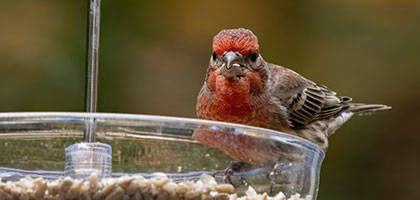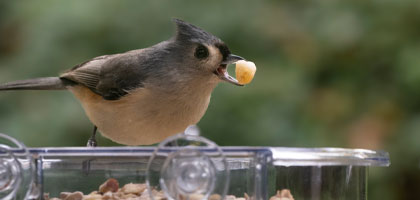Bird feeders are a delightful addition to any garden. They attract a variety of birds, adding life and color to your outdoor space.
However, maintaining a bird feeder involves more than just refilling it with seeds. Regular cleaning is crucial for the health of your feathered visitors.
Unclean feeders can harbor diseases, posing a risk to the bird population. This guide will provide you with comprehensive steps on how to clean your garden bird feeders effectively.
By following these guidelines, you can ensure a safe and healthy feeding environment for the birds, while enjoying their presence in your garden.
The Importance of Regular Bird Feeder Cleaning
Regular cleaning of bird feeders is vital for preventing the spread of avian diseases. Dirty feeders can become breeding grounds for bacteria and mold, which can be harmful to birds.
A clean feeder not only promotes bird health but also attracts more species to your garden. By maintaining feeder cleanliness, you enhance the feeding experience for birds and provide them with a safe environment. Regular maintenance aids in creating a sustainable habitat for local wildlife.
When and How Often Should You Clean Your Bird Feeders?
Maintaining a regular cleaning schedule is crucial for healthy bird watching. Ideally, bird feeders should be cleaned at least once every two weeks. However, more frequent cleaning might be necessary during wet or humid weather.
Keep an eye on feeder conditions and adjust cleaning frequency as needed. Follow this general guideline:
- Clean every two weeks under normal conditions.
- Increase frequency to weekly in wet or humid conditions.
- Clean immediately if mold or disease is observed.
Preparing to Clean: What You Will Need
Before starting the cleaning process, gather all necessary supplies. Having everything ready can make cleaning efficient and effective. Preparation ensures that each step can be completed without interruption.
Here’s a list of essential items for garden bird feeder cleaning:
- Dish soap or a diluted bleach solution
- White vinegar or specialized bird feeder cleaner
- Brushes or cleaning tools
- Rubber gloves
- Clean, soft cloths or towels
- Access to plenty of water
Step-by-Step Guide to Cleaning Your Bird Feeders
Cleaning your bird feeders involves a few crucial steps to ensure they are safe for birds. Begin by removing all seed and debris from the feeder. This initial step will prevent any leftover seed from sticking to the feeder during cleaning.
Next, disassemble the bird feeder as much as possible. Disassembling allows you to reach all parts that need a thorough cleaning. Not all feeders can be fully taken apart, but try to disassemble them for the best results.
Once disassembled, use a brush to scrub each component with soapy water. Pay attention to corners and crevices where mold or bacteria might hide. Different types of feeders may require specific brushes to clean effectively.
After scrubbing, it's essential to rinse all parts thoroughly with clean water. Rinsing will remove any remaining soap or cleaning solution that could be harmful to birds. Make sure all traces of detergent are removed.
Finally, let all components dry completely before reassembling. Proper drying helps prevent mold growth and keeps the feeders safe for birds. Once dry, refill the feeders and place them back in the garden.
Disassembling Your Bird Feeder
To clean thoroughly, start by disassembling your bird feeder as much as the design allows. This step helps to reach hidden spots where dirt collects and germs might breed. If your feeder has multiple parts, separate them for easier access.
Take care to keep track of all parts. It's helpful to take a quick photo before disassembly. This way, you’ll have a clear guide to reassemble it later. Disassembling minimizes the risk of missing a spot during cleaning.
Scrubbing and Sanitizing
Begin scrubbing each disassembled part with a brush soaked in soapy water. A specialized bird feeder brush can reach tight areas. This ensures deep cleaning and removes stuck-on seed residue.
For sanitizing, use a diluted bleach solution or white vinegar. Soak parts for about 10 minutes to effectively kill germs and bacteria. If you prefer natural options, vinegar is both effective and safe.
Remember to scrub gently, especially with plastic feeders. Over-scrubbing might cause scratches where bacteria can settle. Always follow up with sanitizing to ensure maximum cleanliness.
Rinsing and Drying
After scrubbing and soaking, rinse each part under running water. Make sure to remove all soap and cleaning solutions, as residues can be harmful to birds. Tap water works well for this step.
Once rinsed, shake off excess water and lay parts out to dry in the sun. Sunlight can help speed up drying and provides an extra layer of sanitization. If outdoors drying isn’t an option, use a clean, dry towel.
Ensure all parts are thoroughly dry before reassembly. Moisture left in feeders can lead to mold and bacteria growth. A completely dry feeder is safe and ready for use.
Choosing the Right Cleaning Agents
Selecting the right cleaning agents is vital for maintaining safe bird feeders. Always opt for non-toxic, bird-friendly solutions. Conventional cleaners may leave harmful residues.
Consider using the following cleaning agents:
- Diluted bleach solution: Effective for disinfecting but must be well-rinsed.
- White vinegar: A natural alternative that kills germs without harsh chemicals.
- Specialized bird feeder cleaners: Made specifically for safe, effective use on feeders.
These options ensure your feeders are safe without compromising bird health. Always follow up with thorough rinsing to remove any traces.
Safety Precautions During Cleaning
Taking safety precautions while cleaning bird feeders protects you and the birds. Always wear gloves to prevent contact with germs.
Wash your hands thoroughly after cleaning. This simple step avoids spreading any potential diseases. Additionally, keep cleaning agents away from your eyes and mouth.
Ensure the area is well-ventilated when using cleaning products, especially if they contain bleach. This reduces inhalation risks and ensures a safe cleaning process.
Maintaining a Clean Environment Around Your Bird Feeders
Keeping the area surrounding your feeders tidy helps prevent attracting unwanted pests. Regularly remove fallen seeds and debris beneath the feeders.
This practice minimizes the chance of mold and reduces rodent interest. Additionally, regular checks of the feeding area ensure any issues are quickly addressed. A clean environment supports a healthy, bird-friendly habitat.
Addressing Different Types of Bird Feeders
Different bird feeders require varying cleaning approaches due to their unique designs. Tube feeders, for instance, need extra care to clean their narrow parts.
Tray feeders, being open, often accumulate debris quickly, needing frequent maintenance. Hummingbird feeders, with their intricate nooks, require thorough cleaning to prevent mold. Familiarizing yourself with these differences ensures effective cleaning and extends their lifespan. Ensuring each type is cleaned properly contributes significantly to bird health and visitor variety.
Tips for Keeping Your Bird Feeders Clean Longer
Keeping bird feeders clean for extended periods can lessen frequent maintenance needs. Use bird seed of high quality to reduce spoilage and contamination risks.
Consider placing feeders in areas less exposed to extreme weather to lower dirt accumulation. Additionally, rotating feeders can help maintain a clean feeding spot, allowing some feeders to air out while others are in use.
The Role of Clean Feeders in Bird Health and Attracting Wildlife
Clean bird feeders are crucial for preventing disease among birds. Diseases can spread quickly if feeders are dirty or contaminated. By maintaining cleanliness, you support healthier local bird populations.
A well-maintained feeder attracts a wider variety of bird species. Birds are more likely to visit feeders where food is safe and fresh. This diversity can enrich the bird-watching experience, turning your garden into a lively and vibrant wildlife haven.
Conclusion: The Benefits of a Well-Maintained Bird Feeding Station
Maintaining a clean bird feeding station offers numerous benefits. It ensures a safe environment for birds, reducing the spread of diseases. Healthy birds contribute to a balanced ecosystem and enhance the natural beauty of your garden.
Additionally, a well-maintained station can be a source of joy and education. Observing diverse bird species encourages a deeper appreciation for nature. By prioritizing cleanliness, you promote conservation efforts and inspire others in your community to engage in wildlife-friendly practices.




